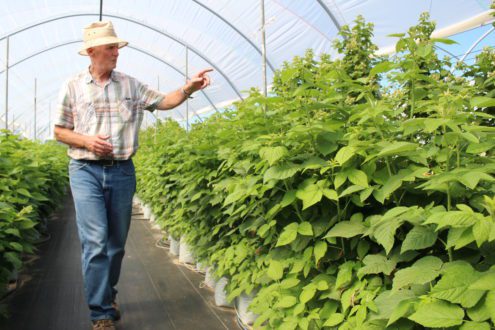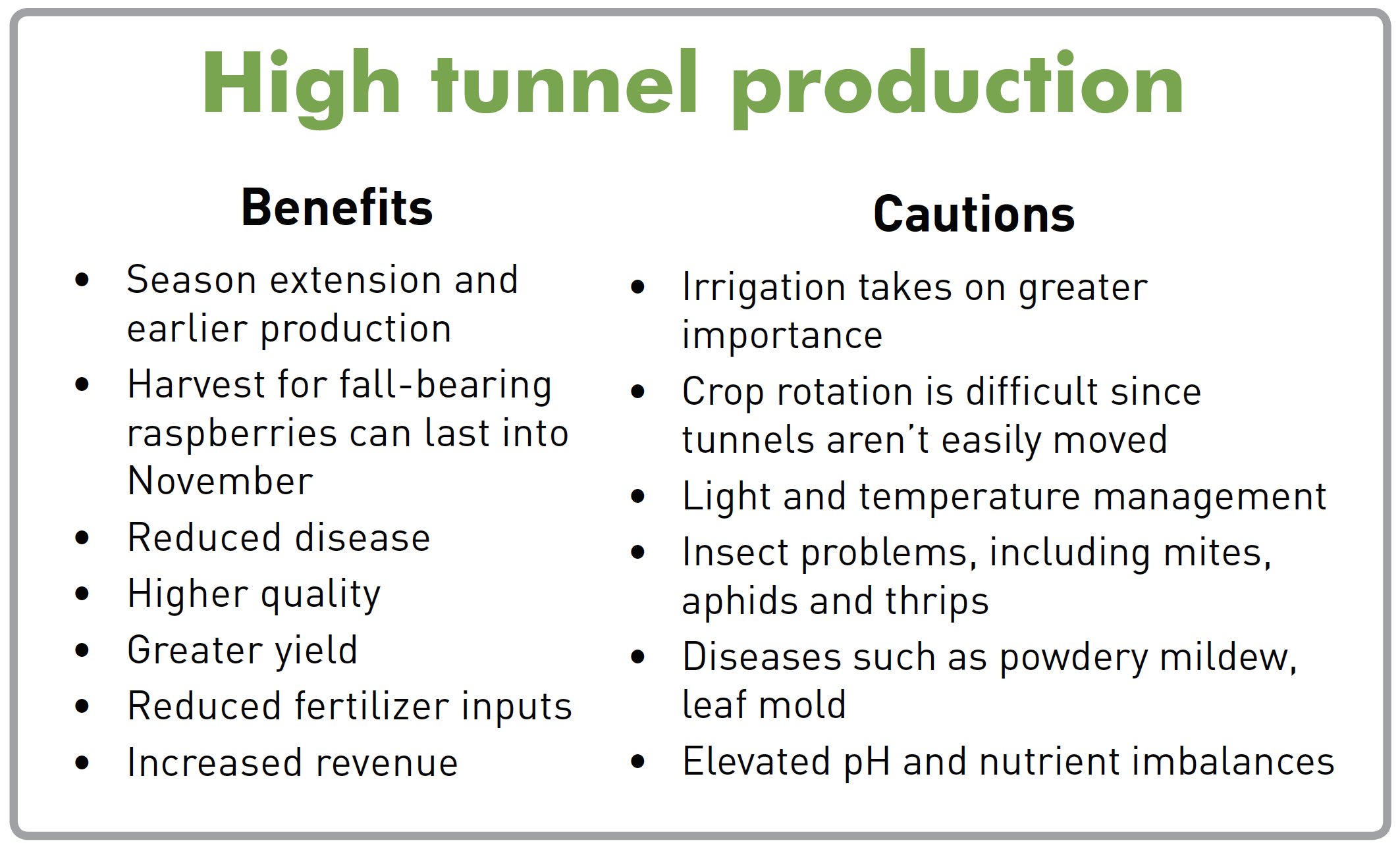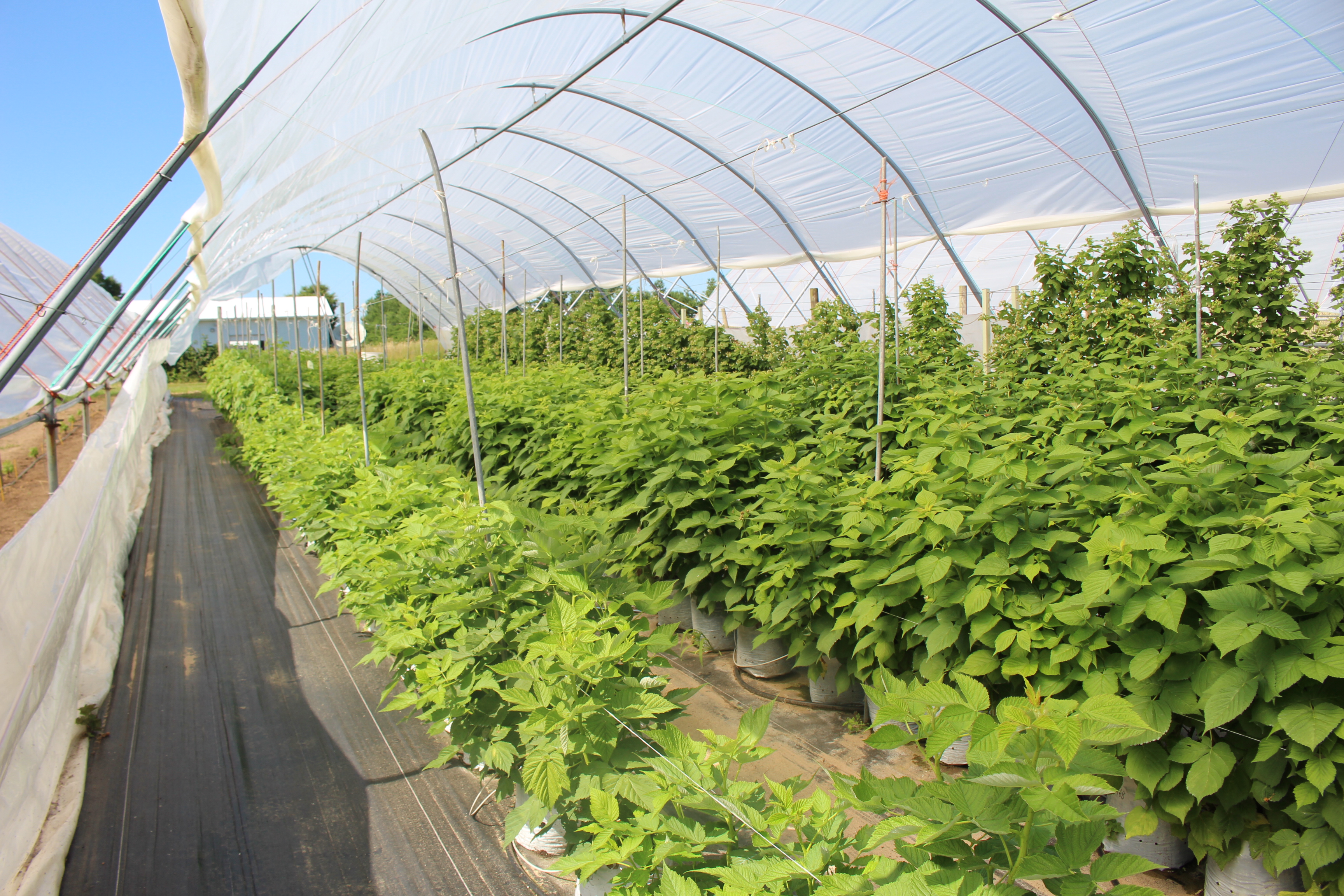

Sep 18, 2018High tunnels bring berries’ success under cover
In many areas of the country, cold winters and humid, variable growing seasons can limit the profitability of raspberries and strawberries, as well as the survival of blackberries. High tunnels alter the crop environment in ways that improve both bramble yields and quality.
“New production systems utilizing potted raspberries and blackberries have the potential to increase marketing options with more flexible harvest times and can be used even when soils are poor,” said Eric Hanson, professor and Extension specialist, Department of Horticulture, Michigan State University (MSU).
Hanson is an authority on using high tunnels to extend the season and improve berry crop yields and berry quality. He has been conducting berry crop research in multi-bay, three-season tunnels since 2001.
As the project director for a USDA-SCRI research and Extension project coordinated across eight universities titled, “Optimizing Protected Culture Environments for Berry Crops,” Hanson oversees the project, coordinates reports and outcomes, and leads activities as related to multiple bay tunnels in Michigan. Details can be found on the project’s website: www.tunnelberries.org.
Speaking at MSU’s Agriculture Innovation Day in Benton Harbor, Michigan, in late June, Hanson said although early studies indicated that in-ground strawberries did not benefit greatly from high tunnels, new single-, double- and triple-row integrated high tunnel strawberry substrate support systems have potential benefits for both production and labor efficiency.


“The yields can be at least double inside the tunnel versus outside the tunnel,” Hanson said. “We’re looking at ways of improving the efficiency of harvest, in particular. So, how can you grow berries where you’re not spending so much on labor that you may not even be able to find? How can you grow a premium quality berry for fresh market? This kind of stuff you’d never consider for processed berries if you have to get a premium price.
“That leads to the crux of the question, which is how do you compete with a Driscoll’s in California – and Mexican berries that are really sold for very little money in our market – throughout the summer now? The peak strawberry volumes out of California are in May. You pay $1.50 or $2 a pound for fresh perishable berries from California because it’s real inexpensive.
“If you’re considering these type of systems, you have to think about how you’re going to market them, and whether or not you can get a premium for producing something locally. You have to distance yourself from the wholesale, Driscoll’s-type berries. Somehow, you have to justify a higher price because you can’t compete with them with added expense at the price for which they can get berries into Michigan.”
In early high tunnel blackberry trials, Hanson has found “the berries are a little bigger and, more importantly, they had essentially no botrytis gray mold.
Hanson said gray mold is a standard problem in field grown raspberries. If it rains for a couple of days, the berries are going to mold, and it’s difficult to control.
“It’s almost absent in the tunnels,” he said. “A number of leaf and cane diseases that are real standard in raspberries just weren’t there because the plants never got wet. We were quite excited about that.”
A few years later, researchers established a raspberry high tunnel planting on campus only to find “some of the plants were going down. We did some testing and found there were nematodes in the soil that were there probably when we planted the plants, and they contained tomato ringspot virus. The virus was in the raspberries; they were going downhill.”
With a high tunnel expense of approximately $40,000 per acre, Hanson said, “you don’t want it sitting fallow for a number of years to control a soilborne disease. So we started working with a potted culture of raspberries.”
The researchers have been using a bark and peat mix in the pots, “and they’ve done very well.”
He said at the current spacing being used, the yield in pots has been 15,000 to 20,000 pounds per acre. “The fruit quality has all been beautiful,” he said.
“When you go to a pot, you’re increasing the costs,” Hanson said. “You start with an expensive tunnel and say, ‘OK, can we justify that?’ You go to a pot, and more expense, so you say, ‘can we justify that?’ Some people say we’re researching ways to grow berries more expensively, which is kind of true.”
Hanson said potted raspberries have done “very well.” They are grown around the world in different locations, mostly to circumvent soil problems.
“It might be a farmer that has heavy, lousy clay soil that isn’t good for raspberries, or it might be a grower who ran into problems like verticillium wilt or nematodes, or some other problem that he wants to avoid. (Potted berry culture) is becoming popular.
Strawberries under the tunnels were initially grown on raised beds, Hanson said.
“The problem with strawberries is the June-bearing strawberries only flower in the spring, fruit very shortly for the window in June and then they’re done. With an expensive system, you would want to be growing day neutral strawberries where they could potentially fruit right through the summer and into the fall.
“I say potentially,” Hanson said, “because the one drawback is heat. On hot days, if you’re growing day neutral strawberries, that heat shuts down the flower production.
Typically, even in Michigan, he said, “we have real down periods in the middle of summer because it’s too hot for the day neutral strawberries to flower.
“They didn’t do too well in the in-ground plots,” Hanson said.
This last spring, strawberries were planted into a table-top system donated by Haygrove, a United Kingdom company.
“They’re the people who make these high tunnels, as well. So they’re manufacturing this thing as a commercial system.”
Hanson explained how strawberries are being grown in bags of coconut core.
“This stuff is becoming real popular around the world as media,” he said. “It’s kind of a byproduct of coconut production for food. It’s the husk of the coconut, and it’s really good for growing plants because it’s quite persistent. It doesn’t break down so you can use it for a long time.
The bags are imported from Malaysia, Hanson said, and are one meter long.
“They are about $2.25 or $2.30 per bag, so it’s pretty reasonable. Because it’s persistent they can use it for a period of time.”
When a bag is charged it quadruples in size as it hydrates. Berry plants are then planted into the bag as it gets hydrated.
– Gary Pullano, FGN Managing Editor
Top photo: Michigan State University’s Eric Hanson, professor and Extension specialist, explains raspberry production in high tunnels. Photos: Gary Pullano

















